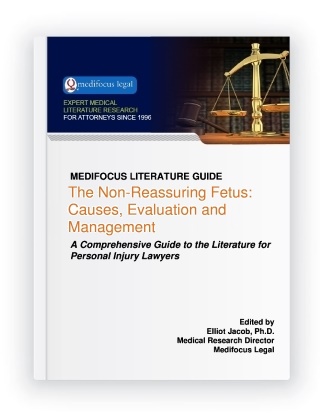The Non-Reassuring Fetus: Causes, Evaluation and ManagementA Comprehensive Guide to the Literature for Personal Injury Lawyers
Publisher: Medifocus Legal
Publication Date: April 28, 2020
Number of Pages: 143
A Comprehensive Guide to the Literature for Personal Injury Lawyers
Publisher: Medifocus LegalPublication Date: April 28, 2020
Number of Pages: 143
As far back as 2005, the American College of Obstetricians and Gynecologists (ACOG) expressed concers about the inappropriate use of the terms "fetal distress" and "birth asphyxia". ACOG recommended replacing the term fetal distress with "non-reassuring fetal status" followed by a description of specific events or findings supporting this diagnosis. Since the term birth asphyxia is not a specific diagnosis, ACOG also recommended that this term should not be used at all. Nevertheless, even 15 years after ACOG issued these recommendations, both of these terms are still used frequently in the medical literature by many authors.
Several risk factors, both maternal and fetal, have been associated with a non-reassuring fetal status which include:
- Multiple births in a single pregnancy
- Breech presentation
- Shoulder dystocia
- Umbilical cord prolapse
- Uterine rupture
- Placental abruption
- Concerns about decreased fetal movement expressed by the mother.
- Evidence of meconium-stained amniotic fluid.
- Cardiotocography patterns showing either fetal tachycardia, fetal bradycardia, decreased variability of the fetal heart rate, or late decelerations.
- Fetal scalp blood sample with evidence of fetal metabolic acidosis and/or elevated fetal blood lactose levels.
The MediFocus Literature Guide to The Non-Reassuring Fetus is a comprehensive Guide to the medical literature for personal injury attorneys who may come to represent families of infants who sustained a serious birth injury as a consequence of a delayed diagnosis or failure to appropriately manage signs and symptoms of fetal distress during pregnancy or labor. This unique Literature Guide consists of over 210 hand-selected references to articles published in peer-reviewed journals with links to the abstract of each article. You also get FREE online access to the FULL-TEXT version of 53 articles. The articles included in the Guide represent the current medical knowledge regarding the causes, evaluation, management, and outcomes of a non-reassuring fetus. The Guide also includes a valuable Author Directory for quickly identifying and locating medical experts in the field for case reviews and expert testimony.
 |
- A comprehensive bibliography of 220 journal article references indexed in MEDLINE published in well respected medical and scientific journals.
- Online access to the abstracts (summaries) of the articles.
- Online access to the free full-text version of 53 articles.
- Links to full-text sources of other articles that are available for purchase directly from individual journal publishers.
- A unique "Author Directory" consisting of the names and institutional affiliations of experts who have published and have specialized knowledge about The Non-Reassuring Fetus: Causes, Evaluation and Management. The "Author Directory" is a valuable resource for quickly identifying and locating experts for case reviews, opinions, and testimony.
Select examples of topics that are covered by the articles referenced in this Guidebook include:
- The legal effects of fetal monitoring guidelines.
- Decision-to-delivery interval: Is 30 min the magic time? What is the evidence? Does it work?
- Umbilical lactate as a measure of acidosis and predictor of neonatal risk: a systematic review.
- Does ST analysis of fetal ECG reduce cesarean section rate for fetal distress?
- Immediate versus deferred delivery of the preterm baby with suspected fetal compromise for improving outcomes.
- Pregnancy outcome and placental pathology in emergent cesarean deliveries for non-reassuring fetal heart rate in laboring versus non-laboring women.
- Interventions for Intrauterine Resuscitation in Suspected Fetal Distress During Term Labor: A Systematic Review.
- Preterm cesarean delivery for nonreassuring fetal heart rate: neonatal and neurologic mo
- Intrapartum care and substandard care: juridical recommendations to reduce the risk of liability.
- Intraoperative findings, placental assessment and neonatal outcome in emergent cesarean deliveries for non-reassuring fetal heart rate.
- Time from uterine incision to delivery and hypoxic neonatal outcomes.
- Mode of delivery has an independent impact on neonatal condition at birth.
- Modalities of fetal evaluation to detect fetal compromise prior to the development of significant neurological damage.
- Delay in intervention increases neonatal morbidity in births monitored with cardiotocography and ST-waveform analysis.
- Timing of caesarean section according to urgency.
- Identification, assessment and management of fetal compromise.
- Immediate versus deferred delivery of the preterm baby with suspected fetal compromise for improving outcomes.
- Management of reported decreased fetal movements for improving pregnancy outcomes.
- Operative versus conservative management for fetal distress in labour.
- The legal effects of fetal monitoring guidelines.
is available in two formats: | |
Order by Phone:To order by phone, please call: Order by Mail:To order by mail, please print and complete this Order Form | |

